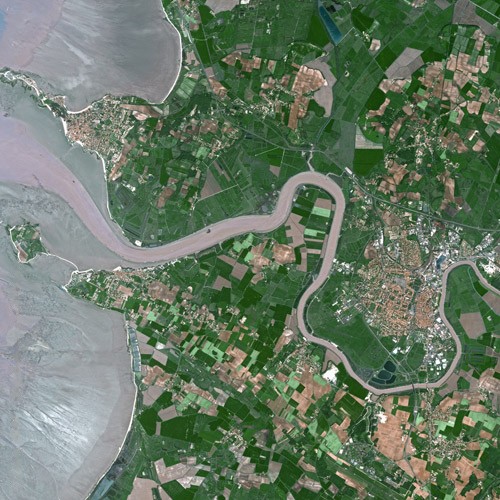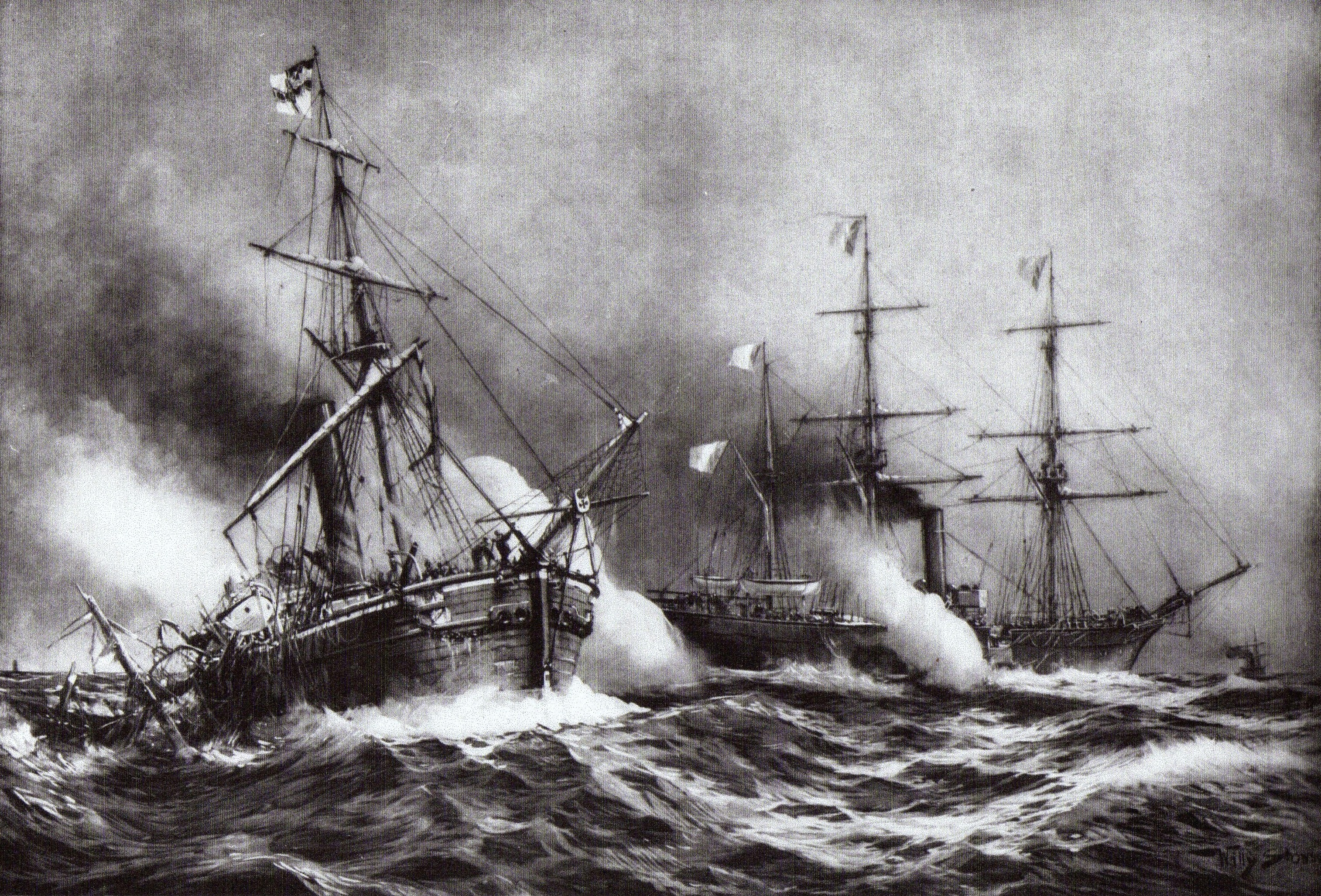|
French Aviso Bouvet (1865)
''Bouvet'' was a sail and steam aviso of the French Navy, lead ship of her class. She is remembered as the opponent of the German gunboat SMS ''Meteor'' during the Battle of Havana in 1870, at the outbreak of the Franco-Prussian War. Career Commissioned on 18 June 1866, ''Bouvet'' served in Mexico, in the Caribbean and off Terre-Neuve. At the outbreak of the Franco-Prussian War, she was sent to the Caribbean, where she intervened to rescue the liner SS ''Nouveau Monde''. Under Commander Franquet, she fought against SMS ''Meteor'' during the Battle of Havana, managing to ram her opponent and knocking out two of her masts, but suffering herself a shot in a steam pipe which forced her to return into Cuban waters and avoid capture. ''Bouvet'' was wrecked on 17 September 1871 off Île-à-Vache Île-à-Vache, (French, also expressed Île-à-Vaches, former Spanish name Isla Vaca; all translate to Cow Island) is a Caribbean island, one of Haiti's satellite islands. It lie ... [...More Info...] [...Related Items...] OR: [Wikipedia] [Google] [Baidu] |
Musée National De La Marine
The Musée national de la Marine (National Navy Museum) is a maritime museum located in the Palais de Chaillot, Trocadéro, in the 16th arrondissement of Paris. It has annexes at Brest, Port-Louis, Rochefort ( Musée National de la Marine de Rochefort), and Toulon. The permanent collection originates in a collection that dates back to Louis XV of France. History In 1748, Henri-Louis Duhamel du Monceau offered a collection of models of ships and naval installations to Louis XV of France, with the request that the items be displayed at the Louvre and made available to students of the Naval engineers school, which Duhamel headed. The collection was put on display in 1752, in a room of the first floor, next to the Academy of Sciences; the room was called "''Salle de Marine''" (Navy room), and was used for teaching. With the French Revolution, the Salle de Marine closed in 1793. The collection was added to models owned by the King personally, to others owned by the Ministry of Nav ... [...More Info...] [...Related Items...] OR: [Wikipedia] [Google] [Baidu] |
François Joseph Bouvet
François Joseph Bouvet (1753–1832) was a French admiral. Early life Son of René Joseph Bouvet de Précourt, a captain in the service of the French East India Company and of the French Royal Navy under Suffren, François Joseph Bouvet went to sea at the age of twelve with his father aboard the ''Villevault '' in 1765. In 1780, Bouvet served in the East Indies in the famous campaign of 1781–83 under the command of Suffren. He was promoted to lieutenant ('' Lieutenant de vaisseau'') in 1785. Naval career On the outbreak of the French Revolution he very naturally took a Republican stance. In 1790, he became second officer aboard the ''Prudence''. In 1790, he was promoted captain (''capitaine de vaisseau'') and received the command of the ''Audacieux'' (80) in the first great fleet collected by the Republic. In the same year (1793) he was promoted to rear-admiral, and command the Second Squadron of the fleet in Brest, which fought the Battle of the First of June (179 ... [...More Info...] [...Related Items...] OR: [Wikipedia] [Google] [Baidu] |
Rochefort, Charente-Maritime
Rochefort ( oc, Ròchafòrt), unofficially Rochefort-sur-Mer (; oc, Ròchafòrt de Mar, link=no) for disambiguation, is a city and communes of France, commune in Southwestern France, a port on the Charente (river), Charente estuary. It is a Subprefectures in France, subprefecture of the Charente-Maritime Departments of France, department, located in the administrative regions of France, administrative region of Nouvelle-Aquitaine (before 2015: Poitou-Charentes). In 2018, it had a population of 23,583. Geography Rochefort lies on the river Charente (river), Charente, close to its outflow into the Atlantic Ocean. It is about 30 km southeast of La Rochelle. Rochefort station has rail connections to La Rochelle, Nantes and Bordeaux. History In December 1665, Rochefort was chosen by Jean-Baptiste Colbert as a place of "refuge, defence and supply" for the French Navy. The Arsenal de Rochefort served as a naval base and dockyard until it closed in 1926. In September 1757, Rochefor ... [...More Info...] [...Related Items...] OR: [Wikipedia] [Google] [Baidu] |
Île-à-Vache
Île-à-Vache, ( French, also expressed Île-à-Vaches, former Spanish name Isla Vaca; all translate to Cow Island) is a Caribbean island, one of Haiti's satellite islands. It lies in the Baie de Cayes about off the coast of the country's southwest peninsula, roughly between the town of Les Cayes and Pointe l'Abacou. It was formerly known by the name of Abacca. Administratively, it became a commune in 1976 as part of the Les Cayes Arrondissement in the Sud department. Île-à-Vache was claimed by the Spanish Empire in 1492 as part of Hispaniola, and for the next two centuries it was known by the name Isla Vaca. In 1697 the island of Hispaniola was formally divided between Spain and France in the Treaty of Ryswick which ended the Nine Years War. France assumed control of the western half of Hispaniola and named it Saint-Domingue, and Isla Vaca took on its current name, Île-à-Vache. Geography The island is about long and wide, with an area of . The western end of the island ... [...More Info...] [...Related Items...] OR: [Wikipedia] [Google] [Baidu] |
Bouvet-class Aviso
The ''Bouvet''-class was a type of sail and steam avisos of the French Navy. Design by Vésigné and La Celle,Avisos de 2ème classe , la Flotte de Napoléon III the ships had a clipper hull, barque rigging and a steam engine with one propeller. They were armed with one 160mm gun and two 120mm guns. ''Bruat'' (1867) is sometimes counted among this class. A model of ''Bouvet'', lead ship of the class, is now on display at Paris naval museum. ... [...More Info...] [...Related Items...] OR: [Wikipedia] [Google] [Baidu] |
Tonne
The tonne ( or ; symbol: t) is a unit of mass equal to 1000 kilograms. It is a non-SI unit accepted for use with SI. It is also referred to as a metric ton to distinguish it from the non-metric units of the short ton ( United States customary units), and the long ton ( British imperial units). It is equivalent to approximately 2204.6 pounds, 1.102 short tons, and 0.984 long tons. The official SI unit is the megagram (symbol: Mg), a less common way to express the same mass. Symbol and abbreviations The BIPM symbol for the tonne is t, adopted at the same time as the unit in 1879.Table 6 . BIPM. Retrieved on 2011-07-10. Its use is also official for the metric ton in the United States, having been adopted by the United States |
Aviso
An ''aviso'' was originally a kind of dispatch boat or "advice boat", carrying orders before the development of effective remote communication. The term, derived from the Portuguese and Spanish word for "advice", "notice" or "warning", an ''aviso'', was later adopted by the French and Portuguese navies to classify their medium-sized warships designed for colonial service. The term continued to be used in the French Navy to classify the patrol frigates until 2012, when the remaining ships of the class were reclassified as offshore patrol ships. It is equivalent to the modern use of "sloop" in other countries. Description The ''Dictionnaire de la Marine Française 1788–1792'' (by Nicolas-Charles Romme) describes ''avisos'' as "small boats designed to carry orders or dispatches". This use became obsolete with the development of means of communicating detailed information at a distance. French ''avisos'' used during World War I and World War II had displacements of 300–7 ... [...More Info...] [...Related Items...] OR: [Wikipedia] [Google] [Baidu] |
French Navy
The French Navy (french: Marine nationale, lit=National Navy), informally , is the maritime arm of the French Armed Forces and one of the five military service branches of France. It is among the largest and most powerful naval forces in the world, ranking seventh in combined fleet tonnage and fifth in number of naval vessels. The French Navy is one of eight naval forces currently operating fixed-wing aircraft carriers,Along with the U.S., U.K., China, Russia, Italy, India and Spain with its flagship being the only nuclear-powered aircraft carrier outside the United States Navy, and one of two non-American vessels to use catapults to launch aircraft. Founded in the 17th century, the French Navy is one of the oldest navies still in continual service, with precursors dating back to the Middle Ages. It has taken part in key events in French history, including the Napoleonic Wars and both world wars, and played a critical role in establishing and securing the French colonial ... [...More Info...] [...Related Items...] OR: [Wikipedia] [Google] [Baidu] |
SMS Meteor (1865)
SMS ''Meteor'' was a of the North German Federal Navy (later the Imperial German Navy) that was launched in 1865. A small vessel, armed with only three light guns, ''Meteor'' took part in the Battle of Havana in 1870 during the Franco-Prussian War. There, she battled the French aviso ; both vessels were lightly damaged, though ''Bouvet'' was compelled to disengage after a shot from ''Meteor'' disabled her engine. After the war, ''Meteor'' returned to Germany, where her career was limited; she served briefly as a survey vessel. From 1873 to 1877, she was deployed to the Mediterranean Sea as a station ship in Constantinople during a period of tensions in the Ottoman Empire. After returning to Germany in 1877, she was decommissioned, converted into a coal hulk and expended as a target ship some time later. Design The s came about as a result of a program to strengthen the Prussian Navy in the late 1850s in the aftermath of the dissolution of the and in the midst of rising t ... [...More Info...] [...Related Items...] OR: [Wikipedia] [Google] [Baidu] |
Battle Of Havana (1870)
The Battle of Havana on 9 November 1870 was an indecisive single ship action between the German gunboat and the French aviso ''Bouvet'' off the coast of Havana, Cuba during the Franco-Prussian War. The battle was the only naval engagement of the war, and showed the inability of either navy to gain a decisive advantage over the other. During the war, most of the French fleet blockaded the German fleet in their harbours, although a few German ships managed to slip out and evade the French, proceeding to engage in commerce raiding against the French merchant marine or harass the French in other ways. The ''Meteor'' was one such ship who managed to elude the French blockade, sailing from Nassau to Havana. A French aviso, the ''Bouvet'', noticed her and sailed outside the harbour of Havana. Havana was at the time ruled by Spain, a neutral country in the conflict, and the captain of the ''Bouvet'' issued a challenge, which the German captain accepted. The ''Meteor'' sailed out of ... [...More Info...] [...Related Items...] OR: [Wikipedia] [Google] [Baidu] |
SS Nouveau Monde
SS is an abbreviation for ''Schutzstaffel'', a paramilitary organisation in Nazi Germany. SS, Ss, or similar may also refer to: Places *Guangdong Experimental High School (''Sheng Shi'' or ''Saang Sat''), China *Province of Sassari, Italy (vehicle plate code) *South Sudan (ISO 3166-1 code SS) *SS postcode area, UK, around Southend-on-Sea *San Sebastián, Spanish city Arts, entertainment, and media *SS (band), an early Japanese hardcore punk band *SS (manga), ''SS'' (manga), a Japanese comic 2000-2003 *SS Entertainment, a Korean entertainment company *''S.S.'', for Sosthenes Smith, H. G. Wells bibliography#All short stories, H. G. Wells pseudonym for story ''A Vision of the Past'' *SS, the production code for the 1968 ''Doctor Who'' serial ''The Wheel in Space'' *''Sesame Street'', American kids' TV show Language *Ss (digraph) used in Pinyin *ß or ss, a German-language ligature * switch-reference in linguistics *''Scilicet'', used as a section sign * (''in the strict sense'') i ... [...More Info...] [...Related Items...] OR: [Wikipedia] [Google] [Baidu] |




